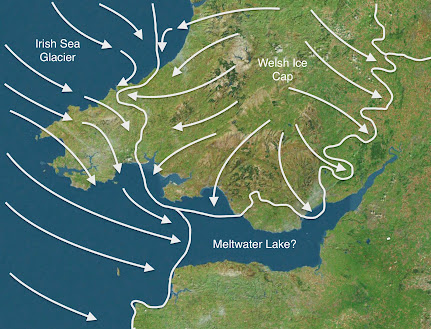This is from my post of the other day. I thought it would be more accessible as a post in its own right.
https://brian-mountainman.blogspot.com/2022/04/the-late-devensian-glaciation-of.html
Suggested Late Devensian relationship between Irish Sea ice and Welsh ice:
The map represents my latest hypothesis. It seems to me to be based on quite sound evidence, much of which has been presented and analysed on this blog.
Suggested Late Devensian relationship between Irish Sea ice and Welsh ice:
In the contact zone between the two ice masses there must have been a southwards diversion of ice streams. There must also have been considerable shifts in the ice contact position, associated with sharp changes in the ice movement directions. Most of the South Pembrokeshire coast is shown as being affected by Irish Sea ice, which must at some stages have flowed more or less west to east. The ice cover over central and south Pembrokeshire might have been rather thin. Swansea Bay was affected mostly by a powerful ice stream made up of ice flowing in the Nedd and Tawe valleys -- but at one time Irish Sea Ice might have dominated, possibly reaching Pencoed and Porthcawl. The maximum extent of the Irish Sea ice might have been c 30 km further east than shown. Gower is shown as completely submerged beneath Welsh ice, but at some stages the south coast might have been affected by Irish Sea Ice. The igneous "giant erratic" found in Limeslade Bay, near Mumbles, might have been emplaced in the Devensian. Mynydd Preseli might have had its own local ice cap in the waxing and waning phases of the glaciation. In Carmarthen Bay there was a conflict between Irish Sea ice coming from the west and Welsh ice flowing via the Tywi and other valleys.

No comments:
Post a Comment